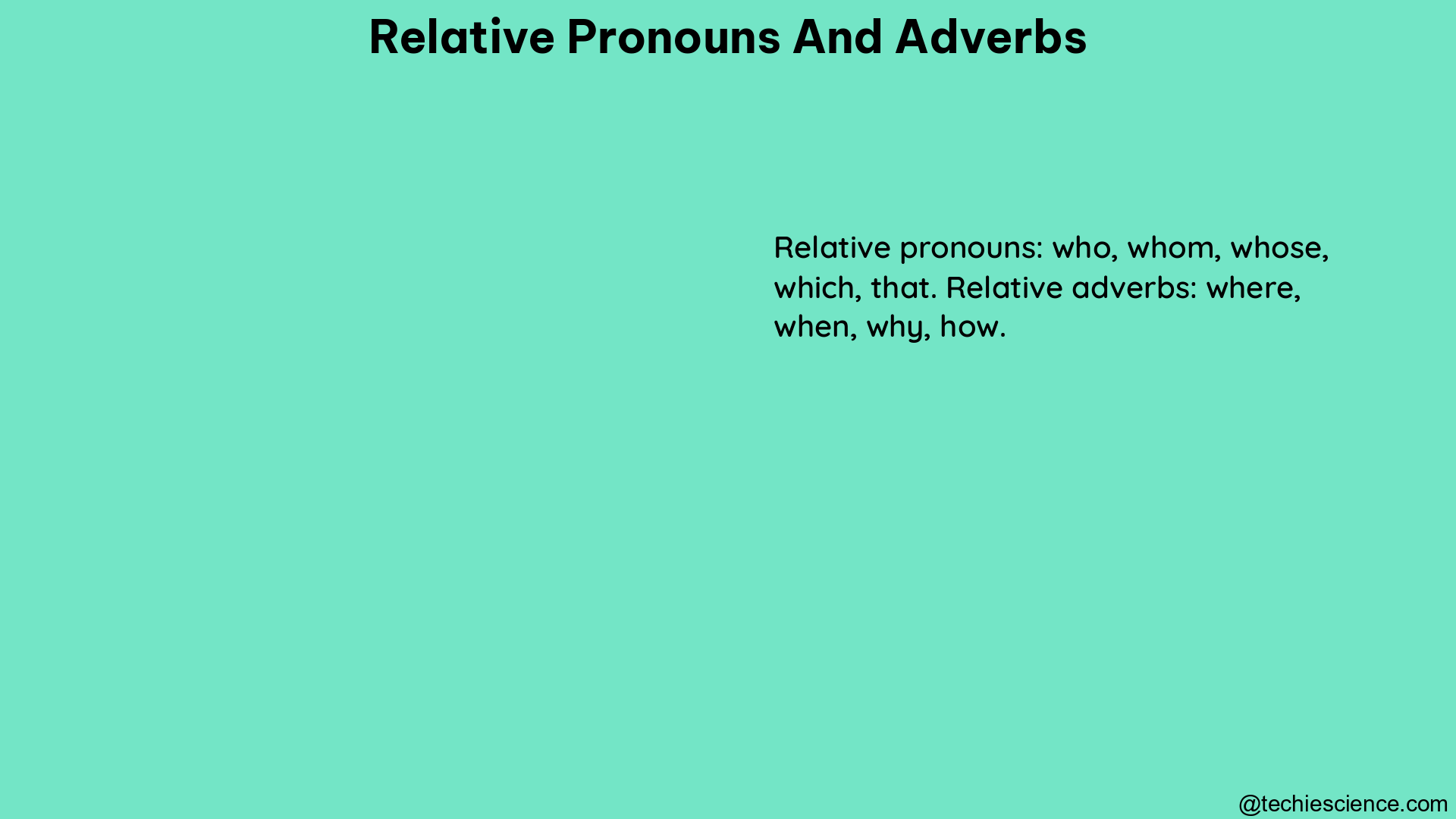Relative pronouns and adverbs are essential components of the English language, playing a crucial role in introducing dependent clauses and providing additional information about nouns or verbs within a sentence. This comprehensive guide delves into the intricacies of relative pronouns and adverbs, offering a detailed exploration of their usage, examples, and grammatical specifications to help you become a proficient writer and communicator.
Understanding Relative Pronouns
Relative pronouns are used to introduce dependent clauses that describe a noun or pronoun. These pronouns serve to connect the dependent clause to the main clause, creating a more cohesive and informative sentence structure. The primary relative pronouns in English are:
- Who:
- Used to provide information about people.
- Can be replaced by a subject pronoun (he, she, they) in the dependent clause.
-
Example: This is the lady who saved our little brother.
-
Whom:
- Used to provide information about people.
- Can be replaced by an object pronoun (him, her, them) in the dependent clause.
-
Example: This is the lady whom we need to thank.
-
Whose:
- Used to show possession.
-
Example: This is the lady whose arms were scratched when she climbed up the tree.
-
Which:
- Adds extra information about an object.
- Always set off by commas.
-
Example: The tree, which has no leaves, is hard to climb.
-
That:
- Provides necessary information about an object.
- Not set off by commas.
- Example: The lady carried a stick that was long and pointy.
It’s important to note that the choice of relative pronoun depends on the specific information being conveyed and the grammatical role of the noun or pronoun in the dependent clause.
Exploring Relative Adverbs

Relative adverbs, on the other hand, come before a dependent clause that describes a noun. These adverbs help to provide additional details about the noun, such as its location, time, or reason. The primary relative adverbs in English are:
- Where:
- Describes a place.
-
Example: Dominique goes to the store where they sell ice cream cupcakes.
-
When:
- Describes a time.
-
Example: It was cold when I left the house.
-
Why:
- Gives a reason.
- Example: Sheela does not know why Meera left town.
Relative adverbs play a crucial role in creating more complex and informative sentences by linking the dependent clause to the main clause, providing a deeper understanding of the context and circumstances surrounding the noun or verb.
Grammatical Specifications and Usage
To effectively use relative pronouns and adverbs, it’s essential to understand their grammatical specifications and proper usage. Here are some key points to consider:
- Essential vs. Non-essential Clauses:
- Essential clauses provide necessary information and are not set off by commas.
- Non-essential clauses provide additional information and are set off by commas.
- Example: The book that I bought yesterday is on the table. (Essential)
-
Example: The book, which I bought yesterday, is on the table. (Non-essential)
-
Restrictive vs. Non-restrictive Clauses:
- Restrictive clauses are essential and limit the meaning of the noun.
- Non-restrictive clauses are non-essential and provide additional information.
- Example: The student who passed the exam will receive a prize. (Restrictive)
-
Example: The student, who passed the exam, will receive a prize. (Non-restrictive)
-
Pronoun Case:
- Subject pronouns (who, which, that) are used in the subject position of the dependent clause.
-
Object pronouns (whom) are used in the object position of the dependent clause.
-
Preposition Placement:
- Prepositions can be placed at the end of the relative clause, especially in informal speech.
- Example: This is the person I was talking about. (Preposition at the end)
-
Example: This is the person about whom I was talking. (Preposition before the relative pronoun)
-
Omission of Relative Pronouns:
- Relative pronouns can be omitted in certain cases, especially with the pronoun “that.”
- Example: The book (that) I bought yesterday is on the table.
Understanding these grammatical specifications and usage patterns will help you effectively incorporate relative pronouns and adverbs into your writing, creating more sophisticated and nuanced sentences.
Exercises and Practice
To reinforce your understanding of relative pronouns and adverbs, it’s essential to engage in practical exercises and activities. Here are some resources to help you practice and improve your skills:
- Practice Relative Pronouns and Adverbs: This comprehensive lesson from Learning Farm provides a range of examples and exercises to help you master the use of relative pronouns and adverbs.
- Relative Pronouns and Adverbs Worksheets: The Everett School District offers a collection of worksheets that allow you to apply your knowledge of relative pronouns and adverbs in various sentence structures.
- Relative Clauses, Pronouns & Adverbs: The University of Nevada, Reno’s guide delves into the intricacies of relative clauses, pronouns, and adverbs, including essential and non-essential clauses, with ample examples for practice.
- English Worksheets Land: This resource provides a range of relative pronouns and adverbs worksheets, offering opportunities to reinforce your understanding and application of these grammatical concepts.
By engaging with these practice resources, you’ll develop a deeper understanding of relative pronouns and adverbs, enabling you to incorporate them seamlessly into your written and spoken communication.
Conclusion
Relative pronouns and adverbs are powerful tools in the English language, allowing you to create more complex and informative sentences. By mastering their usage, you’ll enhance your ability to convey ideas, describe situations, and provide additional context to your writing and speech.
Remember, the key to effectively using relative pronouns and adverbs lies in understanding their grammatical specifications, recognizing the differences between essential and non-essential clauses, and practicing their application through various exercises and examples. With dedication and consistent practice, you’ll become a confident and proficient user of these essential grammatical elements.
References
- Learning Farm. (n.d.). Relative Pronouns and Adverbs. Retrieved from https://www.learningfarm.com/web/practicePassThrough.cfm?TopicID=1690
- Organize and Educate. (2022, August 28). Relative Pronouns and Adverbs – for 4th Grade. YouTube. Retrieved from https://www.youtube.com/watch?v=5e8879YeVJE
- Everett School District. (n.d.). Practice Relative Pronouns and Relative Adverbs. Retrieved from https://www.everettsd.org/cms/lib07/WA01920133/Centricity/Domain/1356/Relative%20Pronouns%20and%20Adverbs.pdf
- University of Nevada, Reno. (n.d.). Relative Clauses, Pronouns & Adverbs. Retrieved from https://www.unr.edu/writing-speaking-center/writing-speaking-resources/relative-clauses-pronouns-adverbs
- English Worksheets Land. (n.d.). Relative Pronouns and Adverbs Worksheets. Retrieved from https://www.englishworksheetsland.com/grade4/1relative.html

Hi…..I’m a graduate with a Bachelor’s degree in English Literature. I wish to do a Masters in the same field someday and continue my career in Academia.
Let’s connect through LinkedIn: